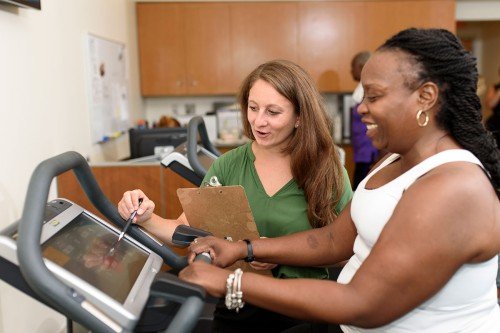Finding the time and energy to exercise is difficult for many people. For men diagnosed with prostate cancer, it can be especially challenging because treatments often sap energy. But exercise can provide important benefits, including some that are not expected.
Lee Jones, an exercise scientist and director of the Cardio-Oncology Research Program at Memorial Sloan Kettering, provides the details.
What are the effects of prostate cancer treatment on overall health?
When someone has prostate cancer, treating the disease is the top priority. But most treatments have side effects. A standard treatment for men with advanced prostate cancer is androgen-deprivation therapy (ADT), also called hormone therapy. Androgens are hormones that fuel prostate cell growth. Removing them with either drugs or surgery can slow the growth of the cancer and even shrink the tumor. There has been a lot of research on the detrimental effects of ADT on someone’s body. It can cause loss of muscle mass and physical strength, sexual dysfunction, loss of bone density, and increased risk of heart disease and diabetes. It’s important to find safe ways to address these side effects — and that’s where exercise can really help.
What have you learned about exercise and side effects from prostate cancer treatment?
As a PhD student in Canada, I was involved in a clinical trial looking at the effects of exercise in men going through ADT. We found that resistance training exercises could alleviate some of the physical impairment caused by this treatment. People tend to think of resistance training as just lifting weights, but it’s really any movement pushing or pulling a force against resistance. It can be as simple as walking up some stairs, standing up and sitting down repeatedly, or doing pushups against a wall. There have been many studies — including by my lab at MSK — further confirming these benefits. Among people receiving ADT, those who exercise can boost strength and muscle mass, reduce their fatigue, and improve quality of life.
We’ve found that both resistance training and aerobic exercise are beneficial. But the biggest issue is usually loss of muscle mass, and resistance training is more effective for slowing or even reversing that. If you can add some aerobic exercise into it, it’s even better.
What types of exercise can people do?
You don’t have to join a gym or put on a tracksuit. There are many ways you can get more activity, including resistance training, in your daily life. If you are shopping, just carrying things around the store can help. If you have children or grandchildren, instead of pushing them in a stroller, pick them up and carry them around for a bit. Of course, you should consult with your doctor before doing these activities to ensure they are safe.
For aerobic exercise, it does not have to involve running or jogging. In most exercise studies we conduct, we prescribe walking as the primary source of aerobic activity. Someone can see tremendous benefits simply from walking three to five days a week.
Do people with prostate cancer express concerns about over-exerting themselves?
It’s understandable that people might worry about overdoing it. But we’ve learned that many health problems after cancer treatment often stem from being sedentary. Just sitting around is one of the worst things you can do for your overall health. I think exercise must be personalized to each patient. Then, as you adapt to your prescribed amount of exercise, maybe you can do more.
Are there exercise benefits for people with cancer that go beyond general fitness?
It’s long been known that exercise is important for overall health, and we’ve found it can alleviate side effects of cancer treatment. But if it also could be an effective treatment against the cancer itself, that’s even more motivation to start being active.
We are seeing intriguing evidence that exercise might affect the biology of the tumor itself. Our clinical research team is now conducting studies to see if improving a person’s overall health through exercise also creates an environment within the body that is less tolerant of cancer cells. It’s already known that being sedentary and overweight causes higher levels of glucose (sugar) and inflammatory molecules that can fuel cancer growth. With exercise training, you’re reducing the concentrations of those things. You’re taking away some of the fuel for the cancer.
How are tumors responding to that? Our team has a clinical trial under way now to study this in people with prostate, breast, or endometrial cancer who are going to have their tumor surgically removed. We will compare tumor samples taken at diagnosis to samples taken when the tumor is removed. We want to see how exercise might alter the molecular and genetic activity of the tumor, and whether the tumor becomes less aggressive. It might sound far-fetched that you could create a less aggressive cancer as a result of exercise, but I don’t think it is. If a person ever wanted a reason to switch a lifestyle, this could be the turning point.






